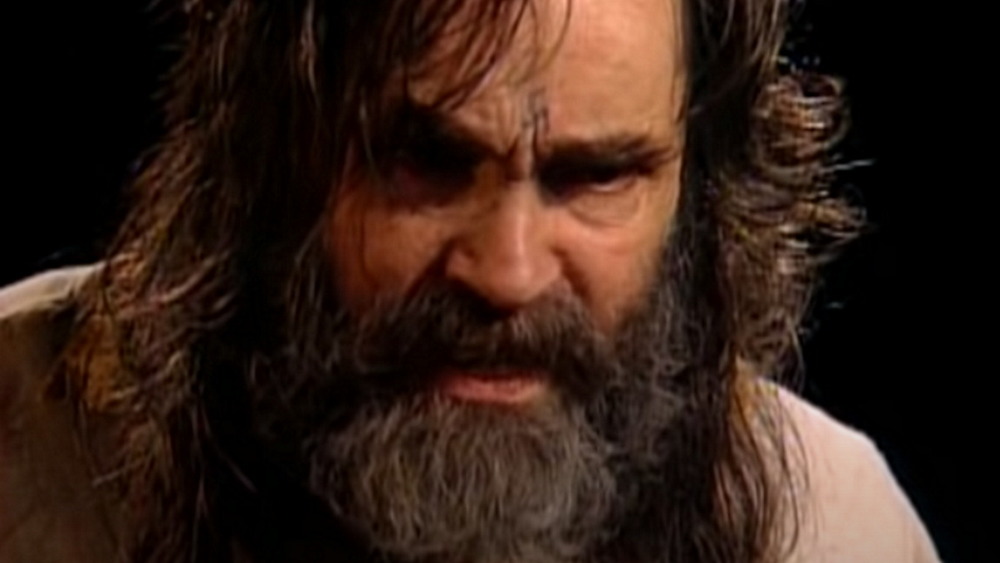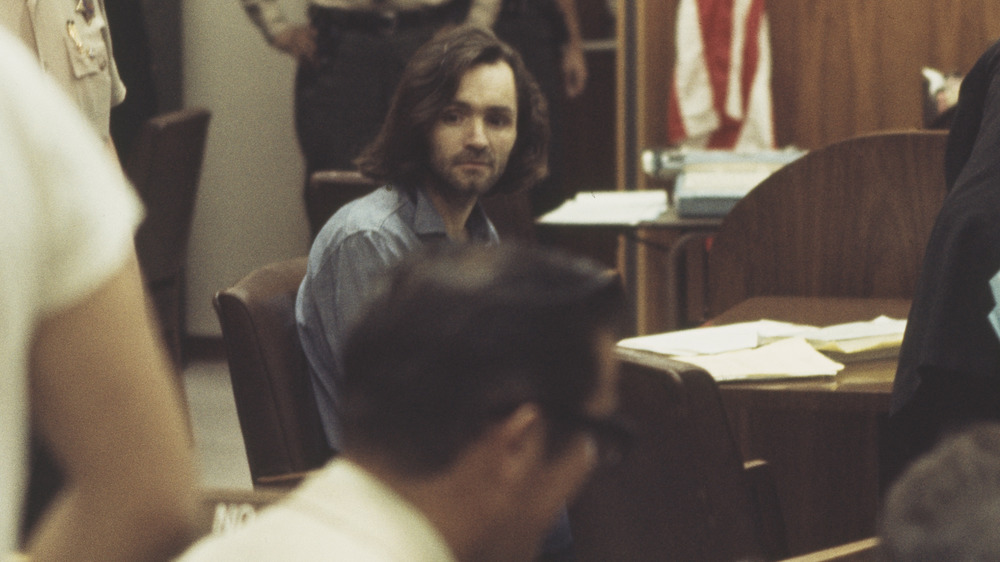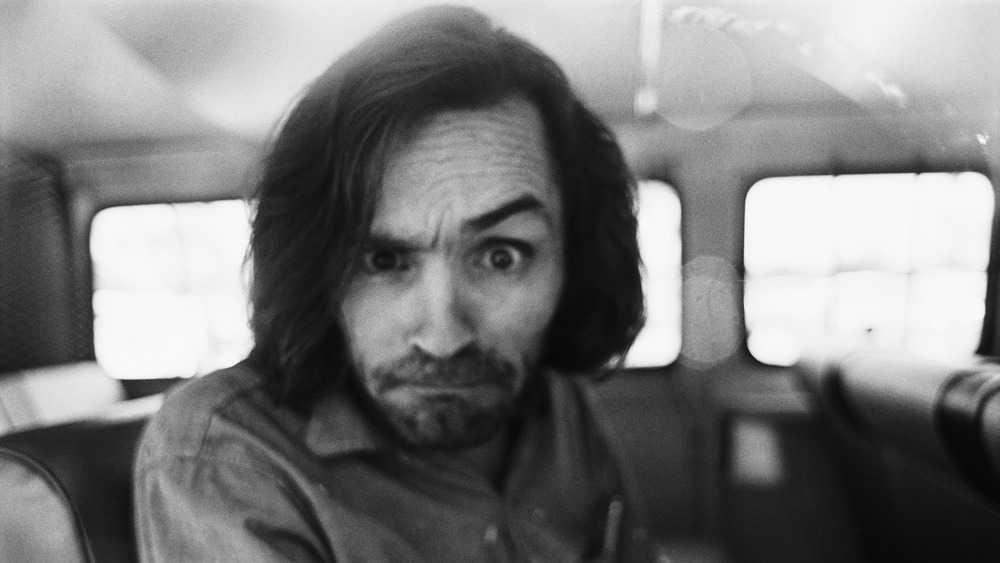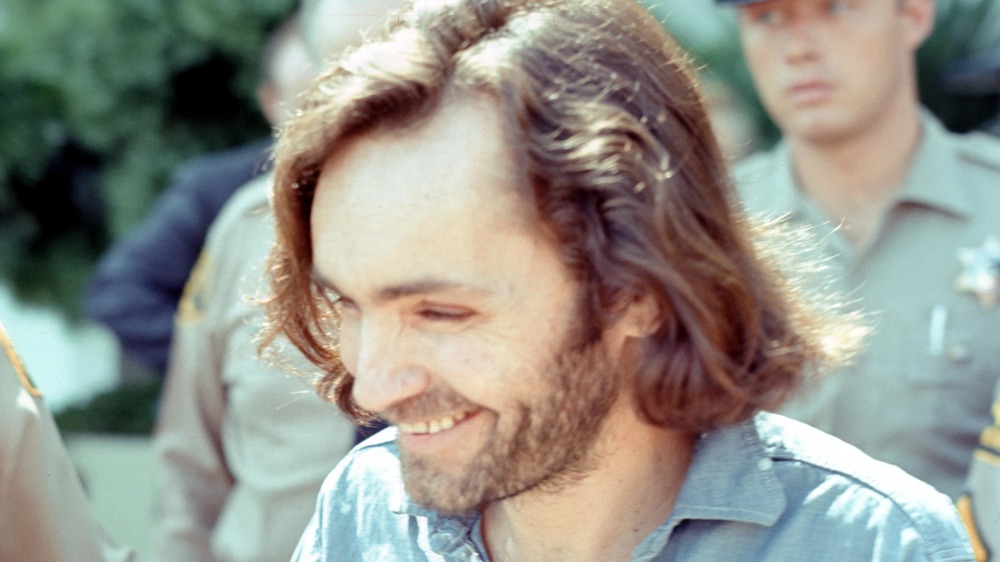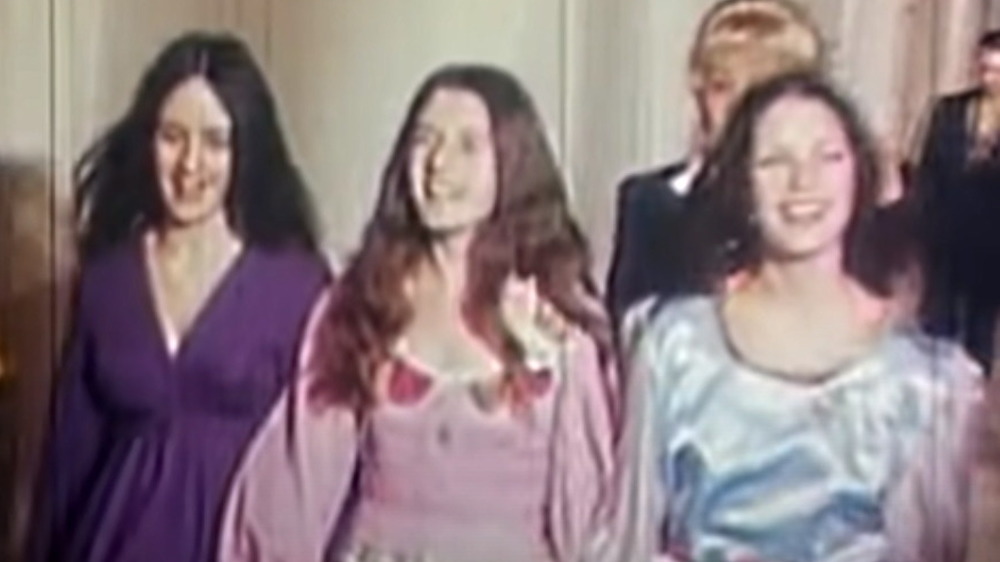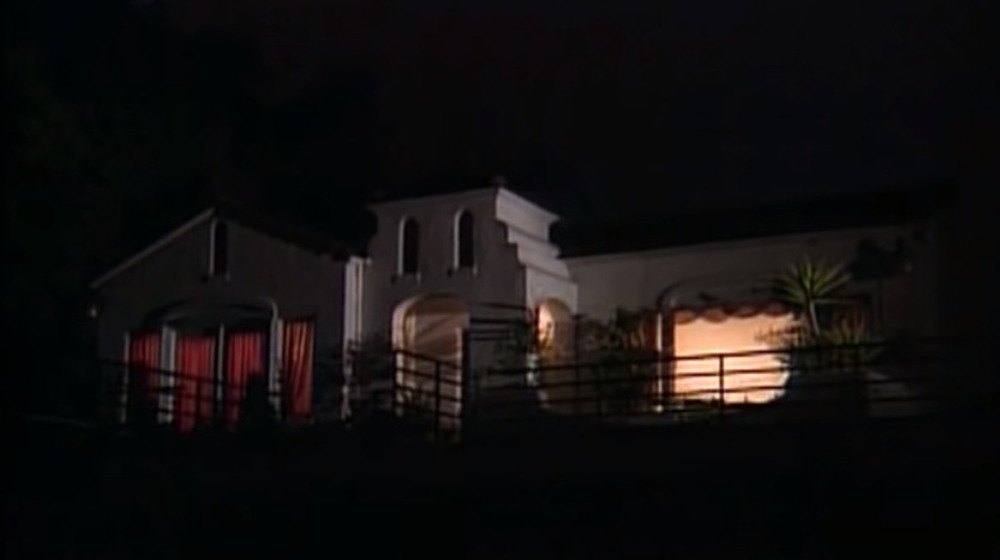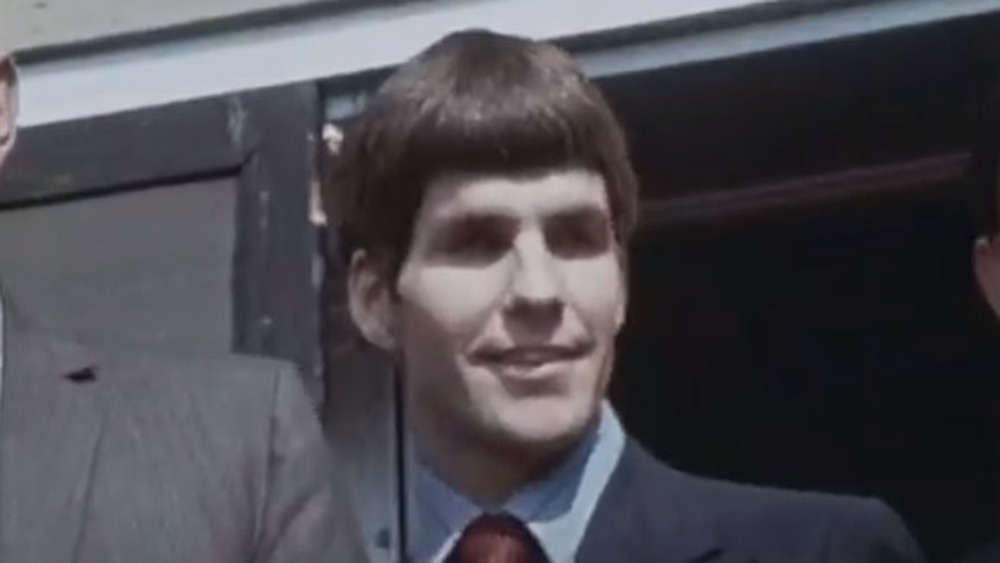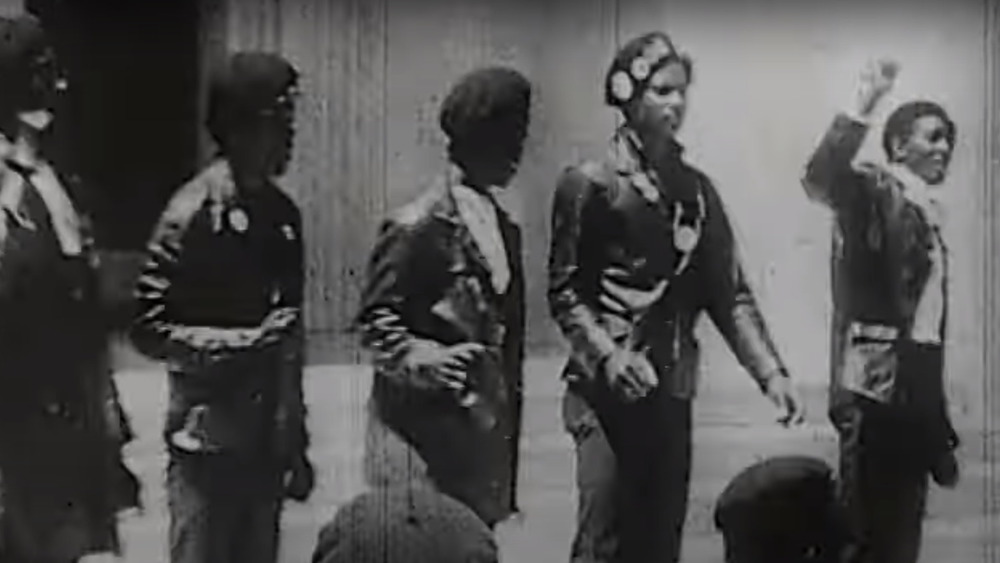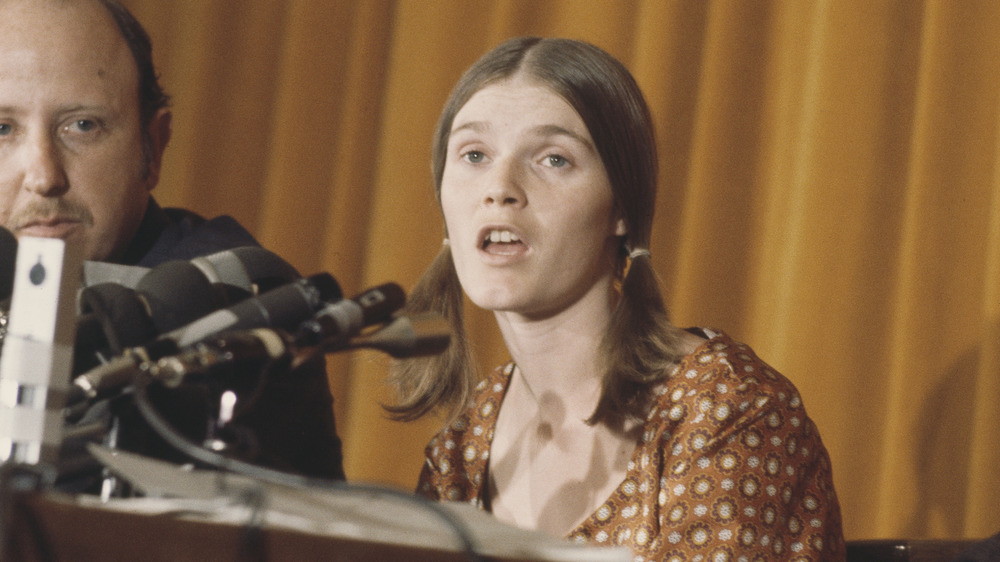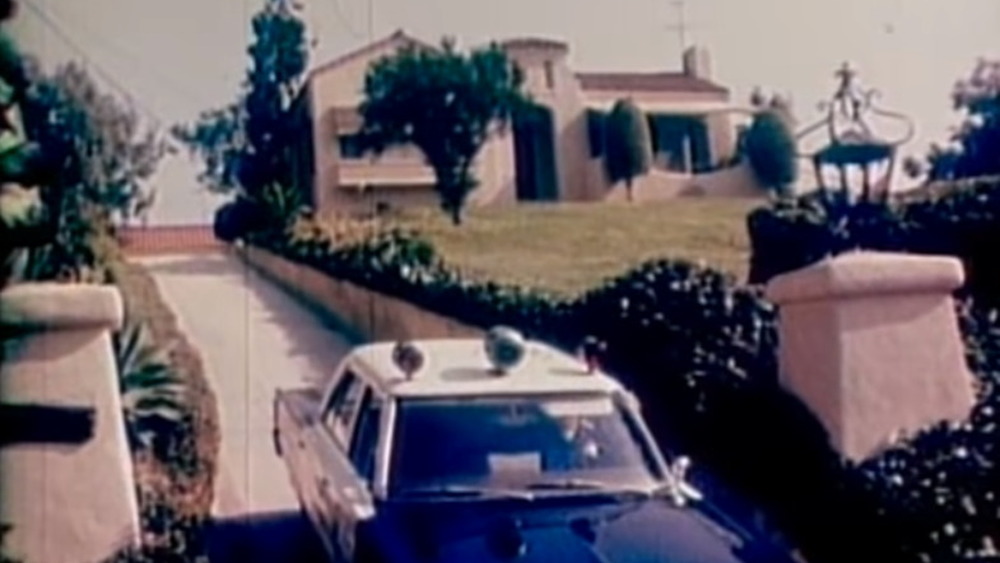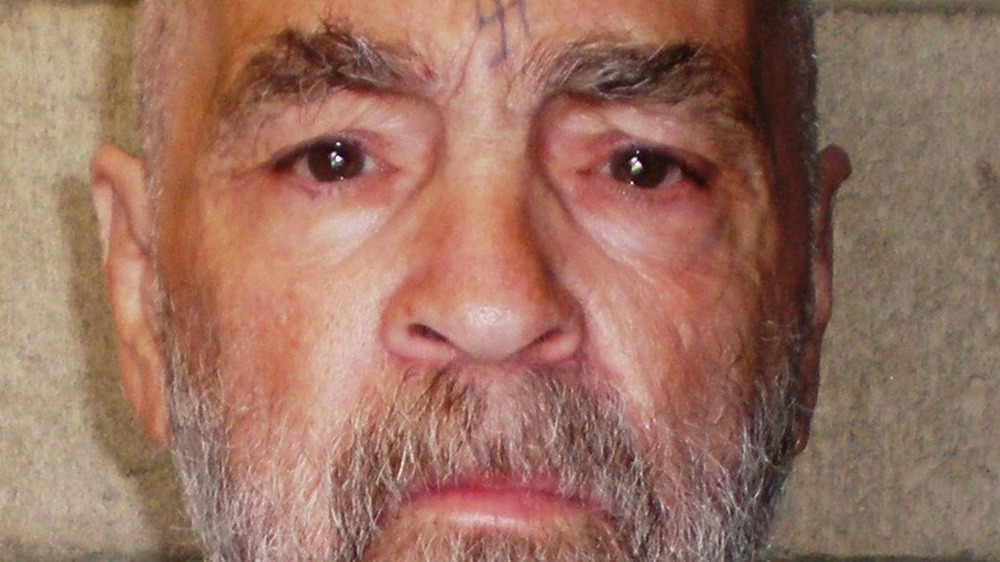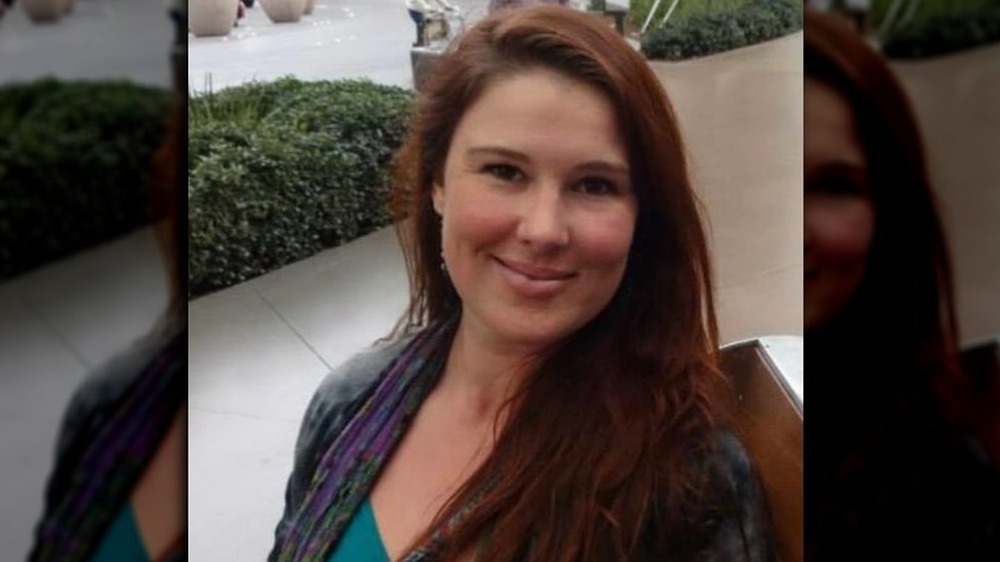The Messed Up Truth Of The Manson Family's LaBianca Murders
Home to the rich and famous, Los Angeles' Benedict Canyon was an idyllic enclave of beautiful homes occupied by beautiful people. Sitting high above the strife of the inner city, 10050 Cielo Drive must have seemed a safe haven for actress Sharon Tate, far from the prying eyes of the press and public. Eight and a half months pregnant, security was foremost on the actress' mind as she awaited the return of her famous husband, director Roman Polanski, from Europe. All illusions of safety were shattered on the night of August 8, 1969, when Tate, Abigail Folger, Jay Sebring, Wojciech Frykowski, and Steven Parent, an associate of the property's caretaker, were savagely murdered by the followers of self-styled cult leader and lifelong criminal Charles Manson.
As tragic as the Tate murders were, they have come to overshadow the victims of the Manson Family's next night of terror. Often overlooked in the pure sensationalism surrounding the deaths of the beautiful, blonde actress and her glamorous friends, the murders of Leno and Rosemary LaBianca were just as tragic, gruesome, and perhaps more terrifying. The LaBiancas, although affluent, were not celebrities or born to wealth — they were businesspeople who enjoyed sharing their comfortable life with their children. Ultimately, it was their deaths that truly plunged Los Angeles into fear and paranoia. A second night of murder left Angelinos wondering who would be next.
This is the true story of Leno and Rosemary LaBianca, the Manson Family's forgotten victims.
The victims: Leno and Rosemary LaBianca
In sharp contrast to the victims of the Tate murders, Leno and Rosemary LaBianca were not part of the Hollywood scene, nor were they socialites or celebrities. According to CieloDrive.com, a website detailing the Tate-LaBianca murders, Leno LaBianca was born in Los Angeles on August 6, 1925. A first-generation American born of Italian immigrants, Leno attended Benjamin Franklin High School, where he excelled in his studies and was the star of the track team. A veteran of the Second World War, LaBianca followed his father into the grocery business after returning from the European theater. In 1959, LaBianca met his second wife, Rosemary Struthers. They soon married.
Raised in an Arizona orphanage, Rosemary LaBianca was likely born in Mexico on December 15, 1929. At age 12, she was adopted by the Harmon family. While working as a carhop at a restaurant in Los Feliz, she met first husband Frank Struthers, with whom she had two children. The couple divorced in 1958. After marrying Leno LaBianca, Rosemary opened a successful dress boutique. A shrewd businesswoman and investor, Rosemary LaBianca made the jump from former waitress to wealthy entrepreneur in under a decade.
In 1968, the LaBiancas moved into Leno's childhood home at 3301 Waverly Drive in Los Angeles' Los Feliz district. It was there that they would meet their tragic end just one year later.
A perfect day was the prelude to a nightmare
As detailed in Helter Skelter: The True Story of the Manson Murders by Vincent Bugliosi and Curt Gentry, Leno and Rosemary LaBianca spent much of the day of Saturday, August 9, 1969, with Rosemary's children, Suzan and Frank Struthers Jr., at Lake Isabella, a popular resort area 150 miles from Los Angeles. Frank Jr., 16, had been spending a fun-filled week with his friend Jim Saffie, whose family owned a cabin there. The LaBiancas had driven up to retrieve their speedboat, which they had left for Struthers' and Saffie's use on the previous Tuesday. Frank was having such a good time with the Saffies that Rosemary and Leno decided to let him stay another day at the lake.
Cautiously winding their way through heavy traffic, the LaBiancas heard the shocking news of the Tate murders on the radio. According to Bugliosi, Rosemary's adult daughter Suzan noted that her mother was particularly upset by the story. Just weeks before, Rosemary had nervously told a friend, "Someone is coming in our house while we're away. Things have been gone through..."
After dropping Suzan off, the LaBiancas stopped at a nearby newsstand run by John Fokianos, where Leno, an avid gambler, bought a newspaper and a racing form. Tired from the road, the LaBiancas arrived home in the early morning hours of August 10. Deciding to put the boat away in the morning, Leno dozed on the sofa, while Rosemary retired to the bedroom.
Charles Manson takes the reins
According to Ed Sanders, author of The Family, Charles Manson was none too pleased with the massacre at Cielo Drive. Although his handpicked killers Charles "Tex" Watson, Susan "Sexy Sadie" Atkins, and Patricia "Katie" Krenwinkel had made good on Manson's commands to gruesomely massacre the occupants at 10050 Cielo Drive and to leave "something witchy" in the form of the word "pig" scrawled in Sharon Tate's blood on the front door, the murders had been chaotic, sloppy, and loud. There had been too many close calls and attempted escapes. Manson's crew had been lucky not to alert neighbors or the police.
Charles Manson would personally ensure the next night's activities went according to his specifications. This time, the victims would be properly restrained, compliant, and unaware they were to be killed. Heeding Watson's complaint about the quality of the weapons used in the Tate murders, Manson would provide a sharp and sturdy military bayonet for use on the second night's killings. Gathering the participants in the Tate murders as well as two other members of the Family, Charles Manson would ride along to the next murder scene and personally oversee the mayhem.
The killers assemble
As documented by Kasabian's testimony in prosecutor Vincent Bugliosi's 1974 chronicle of the Manson case Helter Skelter, Charles Manson called Linda Kasabian, Patricia Krenwinkel, and Leslie Van Houten to the bunkhouse at the Family's hideaway at the Spahn Ranch after dinner on the evening of Saturday, August 9, 1969. Noting that Manson instructed the young women to bring along a change of clothing, Kasabian, who had been the lookout for the Tate killings, became uneasy knowing that she would again be sent on a murderous mission to foment Manson's bloody Helter Skelter plot. "Last night was too messy," Manson told them. "This time I'm going to show you how to do it."
With Manson at the wheel, the participants in the Cielo Drive massacre, Charles "Tex" Watson, Susan Atkins, Krenwinkel, and Kasabian, along with Van Houten and Steve "Clem" Grogan, piled into the yellow and white 1959 Ford Galaxie owned by Spahn Ranch hand John Swartz and headed out in search of their next victims.
After several false starts, the Family at last wound up at a house in Los Feliz. As documented in The Family by Ed Sanders, the home was familiar to Manson. Members of the Family had attended a drug-soaked party there a year before. Their target, however, was to be the house next door — the one with the green Ford Thunderbird and speedboat parked out front. Armed with a pistol, Manson exited the car and made his way up the home's long driveway alone.
Charles Manson's creepy crawl
One of the Manson's Family's favorite pastimes was an activity they called "creepy crawling." Trained by Charles Manson, a career criminal who had spent most of his 34 years behind bars, members of the so-called hippie cult made a game of breaking into random residences in the dead of night. Clad in black and armed with knives, Family members would enter a home under the cover of night and silently creep and crawl from room to room, rearranging the sleeping occupants' possessions. During Manson's trial, Deputy District Attorney Vincent Bugliosi surmised that the creepy crawls were merely dress rehearsals for murder.
In the early morning hours of Sunday, August 10, 1969, Manson slipped into the home of Leno and Rosemary LaBianca to survey the scene. According to Charles "Tex” Watson's memoir Will You Die For Me?, Manson returned to the car moments later and summoned Watson to come with him. They entered the house through an unlocked back door. Rousing Leno LaBianca from his sleep, Manson held a gun on the grocery store president, assuring him that he wasn't going to be harmed. Manson stated he was after money and nothing else. Watson bound LaBianca's hands behind his back with a leather thong while Manson went to the bedroom to retrieve Rosemary. Further assuring the frightened couple that they wouldn't be hurt, Manson left the house with Rosemary LaBianca's wallet. Moments later, Patricia Krenwinkel and Leslie Van Houten entered the LaBianca home with orders to kill.
Tex Watson did Manson's dirty work
With instructions to hitchhike back to Spahn Ranch when they were finished, Tex Watson, Patricia Krenwinkel, and Leslie Van Houten were left to their bloody task. Drawing the blinds, Krenwinkel and Van Houten selected their implements of murder, an eight-inch serrated knife and twin-tined carving fork, from a kitchen drawer and made their way to Rosemary LaBianca's bedroom.
As recounted in Will You Die For Me?, Watson covered the LaBiancas' faces with pillowcases and gagged them with lamp cords. With Krenwinkel and Van Houten holding Rosemary LaBianca at bay in the bedroom, Watson ripped open Leno LaBianca's pajama shirt and plunged his chrome-plated bayonet into the screaming man's throat. In a murderous rage, Watson brought the blade down on LaBianca a total of 12 times. Echoing Cielo Drive victim Abigail Folger's dying words to Patricia Krenwinkel the previous night, Leno LaBianca begged Watson to stop stabbing him, pleading, "Don't stab me anymore. I'm dead. I'm dead..."
Panicked by her husband's screams, Rosemary LaBianca valiantly struggled with her attackers. Coming to Van Houten and Krenwinkel's aid, Watson entered the bedroom and stabbed the woman several times, effectively ending LaBianca's fight. Krenwinkel then descended on the dying woman with a kitchen knife. Reminding a hesitant Van Houten that Manson demanded all present to "get [their] hands dirty," Watson handed her his blade. She then proceeded to stab the dying woman in the lower back an estimated 16 times.
Manson wanted to frame the Black Panthers
As Tex Watson, Patricia Krenwinkel, and Leslie Van Houten carried out their grisly mission, Charles Manson, Susan Atkins, Linda Kasabian, and Steve "Clem" Grogan left the scene. According to Vincent Bugliosi, author of Helter Skelter, Manson gave Kasabian Rosemary LaBianca's wallet and instructed her to wipe off any incriminating fingerprints and remove the change. LaBianca's drivers license and, most importantly, her credit cards were to remain untouched.
Manson, again taking the wheel of the '59 Ford Galaxie, explained that he was going to drive to a predominantly Black neighborhood, where Kasabian was to toss the wallet on the sidewalk. Explaining that a person of color would find the wallet and use the credit cards, Manson hoped that the press and the authorities would blame the murders on the Black Panthers. With the blame deflected from the Family and placed on the Black political organization, Manson believed that the country would edge nearer to "Helter Skelter," an apocalyptic race war from which Manson and his followers would emerge as victors.
Inexplicably, Manson changed his mind at the last minute and instead drove to a nearby gas station, where he instructed Kasabian to leave the wallet in the women's restroom. Kasabian, now fearful after two nights of murder, instead hid LaBianca's wallet inside a toilet tank rather than leaving it where it could be easily found. A key piece of evidence, the wallet was finally discovered four months after the August 10 killings.
Milkshakes and a murder foiled
While Linda Kasabian deposited Rosemary LaBianca's wallet in the women's restroom of the Standard service station in Sylmar, California, Charles Manson walked to the Denny's restaurant next door, where he ordered four milkshakes for his crew. In Helter Skelter, Vincent Bugliosi notes the incongruity of Manson's late-night treat with the events of the night, writing, "Probably at the same time the LaBiancas were being murdered, the man who had ordered their deaths was sipping a milkshake."
As detailed in Bugliosi's book, the group then drove to a beach near Venice, where Kasabian and Manson shared an intimate moment in which she told the cult leader she was pregnant. Despite the violence of the past two days, Kasabian said that "[Manson] just sort of made me forget about everything, made me feel good."
Nevertheless, murder was still on Manson's mind. Hoping to increase the night's body count, he suggested that they take out another "piggy," an actor acquaintance of Kasabian's named Saladin Nader. Best known for co-starring the 1964 Kahlil Gibran biopic The Broken Wings, Nader had once given a ride to a hitchhiking Kasabian and Family member Sandra Good. Upon arriving at Nader's Venice apartment, Manson gave Kasabian a folding knife and instructed her to slit the actor's throat. Protesting that she was no killer, she intentionally led Manson to the wrong apartment, an act that likely saved Nader's life.
The shocking LaBianca crime scene
As detailed in The Family by Ed Sanders, Rosemary LaBianca's son, Frank Struthers Jr., returned home from his week with friends at Lake Isabella at around 8:30 p.m. on August 10. Dropped off in front of the Waverly Street house, Struthers noticed that Leno LaBianca's car was parked on the street with the speedboat still attached. Thinking it unusual for his stepfather to leave the vehicle on the street, Struthers approached the house. Struthers knocked on the back door, to no avail. Concerned, he walked down the street and called his sister Suzan from a nearby burger restaurant.
At around 10:30 p.m., Suzan Struthers and her fiancé, Joe Dorgan, arrived at the Waverly Street house. Retrieving the house keys from Leno's unlocked car, Dorgan and Frank Struthers Jr. entered the home. What they saw there was a scene out of a nightmare.
Leno LaBianca lay in a crouched position in the living room, his head covered with a white pillowcase. A kitchen knife protruded from his throat, and a twin-tined carving fork was embedded in his abdomen. The word "WAR" was ominously carved in his flesh. Rosemary LaBianca's body was located in the bedroom. Also hooded with a pillowcase, her body was riddled with stab wounds. Scrawled on the living room walls were the words "Rise" and "Death to pigs" in the victims' blood. In the kitchen, the refrigerator door bore the bloody message "Healter Skelter [sic]." Excepting Mrs. LaBianca's wallet, no valuables were missing.
Los Angeles was gripped by terror in the wake of the murders
According to Los Angeles Deputy D.A. Vincent Bugliosi, investigators were initially reluctant to link the LaBianca and Tate murders. At the time, the police regarded the Waverly Street killings as a copycat crime. Regardless of the official position of the authorities, the general public could easily see the parallels in the crimes. Gripped by fear, Los Angeles held its breath waiting for the next round of gruesome slayings.
On the 50th anniversary of the Tate-LaBianca murders, Linda Deutsch, the Associated Press reporter who broke the story of the Cielo Drive killings, described the mood of the city to Tara Brown of 60 Minutes Australia. "You had a city that was in lockdown," Deutsch recalled. "People were buying alarm systems for their houses. People carried guns — they were sure that they were targets. And then when the LaBiancas were killed, that sort of cemented the idea that there were mad killers on the loose."
"There was a lot of fear in L.A.," Vincent Bugliosi told KABC-TV in 2015. "The sale of guard dogs and guns rose dramatically overnight [...] particularly in the movie colony. They were just terrified."
The fates of the killers
On August 16, 1969, authorities raided Spahn Ranch and arrested Manson and 25 Family members. Charged with auto theft, Manson was released when it was discovered that the arrest warrant had been misdated.
As documented in Helter Skelter, Susan Atkins, jailed at the Sybil Brand Institute after being implicated in the earlier murder of music teacher Gary Hinman, leaked details of the Tate-LaBianca crimes to fellow inmates, who, in turn, alerted authorities. Charged with murder, Manson, Tex Watson, Atkins, Patricia Krenwinkel, and Leslie Van Houten were sentenced to death. In exchange for immunity, Linda Kasabian became a witness for the prosecution. Her testimony was instrumental in convicting Manson and his followers. As reported by Rolling Stone, Steve Grogan was sentenced to life imprisonment for the Family's murder of ranch hand Donald "Shorty" Shea. Paroled in 1985, Grogan is the only one of the killers who's been released from prison.
In 1972, California abolished the death penalty. The sentences of murderers were commuted to life. Susan Atkins died of brain cancer in 2009. Charles Manson, suffering from colon cancer, died of cardiac arrest in 2017. As of this writing, Watson, Krenwinkel, and Van Houten remain in prison.
The death of Ariana Wolk, a haunting postscript
In an eerie echo of the August 1969, murders, Ariana Wolk, the granddaughter of Rosemary LaBianca, was stabbed to death in her Denver, Colorado, apartment. As reported by Denver NBC affiliate KUSA, the body of Wolk, 40, was discovered by Denver police on July 3, 2020. Ariana Wolk, the daughter of Suzan Struthers-La Berge, who was present when the bodies of her mother and stepfather were discovered, was found lying on her bed in a pool of blood. Pronounced dead at the scene, Wolk sustained sharp-force injuries to her neck. Defensive wounds marked her hands.
According to Denver's KCNC-TV, fingerprints discovered on a cup in Wolk's yard led authorities to arrest 24-year-old Jose Sandoval-Romero in Colorado Springs. An acquaintance of Wolk's, Sandoval-Romero confessed to the crime.
Wolk's familial connection to the LaBianca murders, noted by several websites devoted to the Manson case, was first reported by The Mercury News. In December 2020, British tabloid the Daily Mail brought international attention to the story, after which it was widely reported by the mainstream press.
